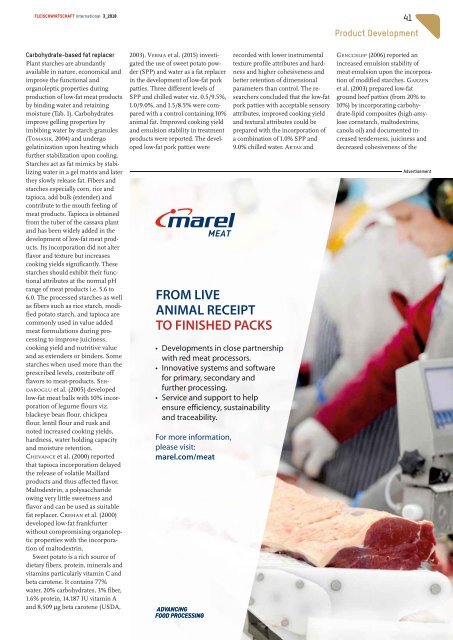FLEISCHWIRTSCHAFT international 3/2018
- No tags were found...
Create successful ePaper yourself
Turn your PDF publications into a flip-book with our unique Google optimized e-Paper software.
Fleischwirtschaft <strong>international</strong> 3_<strong>2018</strong><br />
41<br />
Product Development<br />
Carbohydratebased fat replacer<br />
Plant starches are abundantly<br />
available in nature, economical and<br />
improve the functional and<br />
organoleptic properties during<br />
production of lowfat meat products<br />
by binding water and retaining<br />
moisture (Tab. 1). Carbohydrates<br />
improve gelling properties by<br />
imbibing water by starch granules<br />
(TOMASIK, 2004) and undergo<br />
gelatinization upon heating which<br />
further stabilization upon cooling.<br />
Starches act as fat mimics by stabilizing<br />
water in a gel matrix and later<br />
they slowly release fat. Fibers and<br />
starches especially corn, rice and<br />
tapioca, add bulk (extender) and<br />
contribute to the mouth feeling of<br />
meat products. Tapioca is obtained<br />
from the tuber of the cassava plant<br />
and has been widely added in the<br />
development of lowfat meat products.<br />
Its incorporation did not alter<br />
flavor and texture but increases<br />
cooking yields significantly. These<br />
starches should exhibit their functional<br />
attributes at the normal pH<br />
range of meat products i.e. 5.6 to<br />
6.0. The processed starches as well<br />
as fibers such as rice starch, modified<br />
potato starch, and tapioca are<br />
commonly used in value added<br />
meat formulations during processing<br />
to improve juiciness,<br />
cooking yield and nutritive value<br />
and as extenders or binders. Some<br />
starches when used more than the<br />
prescribed levels, contribute off<br />
flavors to meatproducts. SER<br />
DAROGLU et al. (2005) developed<br />
lowfat meat balls with 10% incorporation<br />
of legume flours viz.<br />
blackeye bean flour, chickpea<br />
flour, lentil flour and rusk and<br />
noted increased cooking yields,<br />
hardness, water holding capacity<br />
and moisture retention.<br />
CHEVANCE et al. (2000) reported<br />
that tapioca incorporation delayed<br />
the release of volatile Maillard<br />
products and thus affected flavor.<br />
Maltodextrin, a polysaccharide<br />
owing very little sweetness and<br />
flavor and can be used as suitable<br />
fat replacer. CREHAN et al. (2000)<br />
developed lowfat frankfurter<br />
without compromising organoleptic<br />
properties with the incorporation<br />
of maltodextrin.<br />
Sweet potato is a rich source of<br />
dietary fibers, protein, minerals and<br />
vitamins particularly vitamin C and<br />
beta carotene. It contains 77%<br />
water, 20% carbohydrates, 3% fiber,<br />
1.6% protein, 14,187IU vitamin A<br />
and 8,509 µg beta carotene (USDA,<br />
2003). VERMA et al. (2015) investigated<br />
the use of sweet potato powder<br />
(SPP) and water as a fat replacer<br />
in the development of lowfat pork<br />
patties. Three different levels of<br />
SPP and chilled water viz. 0.5/9.5%,<br />
1.0/9.0%, and 1.5/8.5% were compared<br />
with a control containing 10%<br />
animal fat. Improved cooking yield<br />
and emulsion stability in treatment<br />
products were reported. The developed<br />
lowfat pork patties were<br />
recorded with lower instrumental<br />
texture profile attributes and hardness<br />
and higher cohesiveness and<br />
better retention of dimensional<br />
parameters than control. The researchers<br />
concluded that the lowfat<br />
pork patties with acceptable sensory<br />
attributes, improved cooking yield<br />
and textural attributes could be<br />
prepared with the incorporation of<br />
a combination of 1.0% SPP and<br />
9.0% chilled water. AKTAS and<br />
GENCCELEP (2006) reported an<br />
increased emulsion stability of<br />
meat emulsion upon the incorporation<br />
of modified starches. GARZEN<br />
et al. (2003) prepared lowfat<br />
ground beef patties (from 20% to<br />
10%) by incorporating carbohydratelipid<br />
composites (highamylose<br />
cornstarch, maltodextrins,<br />
canola oil) and documented increased<br />
tenderness, juiciness and<br />
decreased cohesiveness of the<br />
Advertisement

















